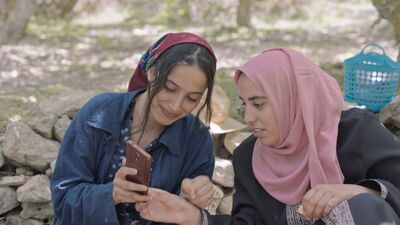You mentioned earlier that the leaves of the fig trees are so big they block out the sun. But there is still so much light in this film. Can you talk a bit about working with your cinematographer to capture that naturalistic light?
I think our countries have so much light. That’s what you don’t see in our cinema. We see darkness most of the time, but our country is filled with so much light. So much so, that it was a problem for the cinematographer. We had too much light. Usually, the problem is that we need to add more lights for a scene. But we had to hide the sun sometimes and at other times we had to catch it. So for every scene we had to shoot at the same hour every day. Another issue was that we shot the film in two different years because of money issues. So it was really challenging. The lunch scene, for example, we had to shoot it in two different seasons of figs. Ultimately, it was all about using natural light with no reflector. Just natural light and being at the right place at the right time.
I’m glad you brought up the lunch scene. I love that scene so much. All of that food looks so good. That scene really highlights the communal aspects of the film. They all share food with each other. Later, despite all their disagreements earlier, all of the girls and women rally around each other when the boss tries to harass them or withhold their pay.
I was interested in traditional solidarity. Because actually, there’s more and more communities now actually. There’s communities lobbying. There’s a lot of groups in the world. Now, there’s groups on social media too. Most of the time, it’s people who have the same values or share the same political point of views or it’s people who look the same. They get together. That’s what community is now. I felt like a traditional community was more about how we don’t have a choice but to be together, even if we don’t have the same point of view.
You can see with the girls, even in terms of the way they wear their veils, their relationships with men, with generations, and with religion are not the same. They are not the same in terms of conservatism. There’s a lot of nuances between them. They don’t agree on everything. The girls are very different from each other, but at the end they still have this very strong bond. That’s why I say traditional, because they are living in a traditional way. There’s something interesting about how to look at solidarity between human beings and to look back to more traditional ways of living together, and contrast that with the way we build solidarity now.

